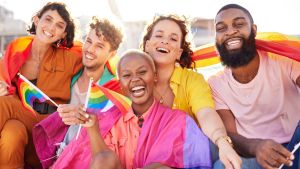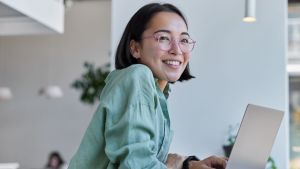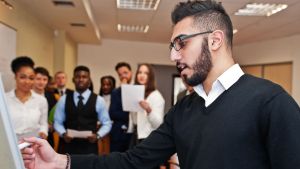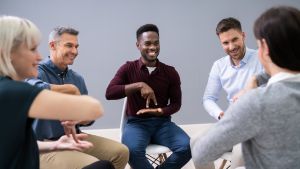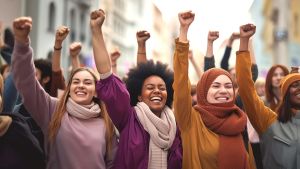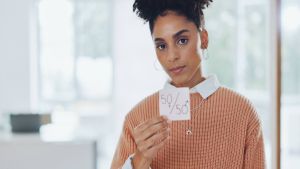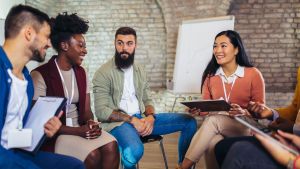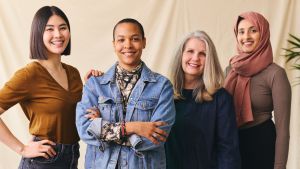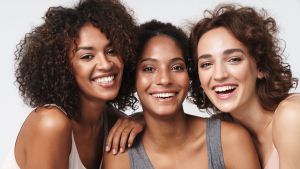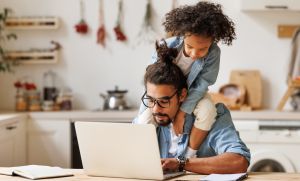For the third year in a row, Fair360, formerly DiversityInc has selected several extraordinary women to profile in our Women We Love feature. The six women whose stories you’ll read have two things in common: They overcame obstacles or cultural assumptions to become leaders in their fields, and they have continued, throughout their lives, to give back to others.
Kathy Martinez is one of those women. Here is her story:
FAST FACTS
Continue reading this and all our content with a Fair360 subscription.
Gain company-wide access to our premium content including our monthly webinars, Meeting in a Box, career advice, best practices, and video interviews with top executives.MembershipsAlready a member? Sign in.My dad worked for a number of defense contractors, including Rockwell Collins and Northrop Grumman, and my mom cleaned houses and ultimately became a driver for Braille Institute. I was born in New Mexico and grew up in Southern California.
I was one of six kids. I’m blind and my sister is blind, and we are in the middle. Where we came from in New Mexico, it was very rural and very poor and most of the disabled kids were sent away. There was no example for my parents of kids being disabled and being integrated into the school system.
But my mother had a deep commitment that I would not go to a school for the blind. I’m two years older than my sister who’s blind, so I went first. My mother had to fight very hard. I was tested and tested and tested and I finally made it into the public kindergarten. For the first time there, I realized I was different. I would hear other kids on the playground, rush toward them and crash into other people or toys.
In school, that was the first time I realized I would have to negotiate the world differently. At that age, kids know no limits. They don’t believe you can’t do things and they would include me in ways kids can. I figured out ways I could play dodge ball, tetherball and other games. I couldn’t do it all but they figured out ways I could. I dealt with the teasing but my sister, Peggy, and I were very supported by non-disabled peers.
I feel very blessed to have had that experience. There was enough sameness. My parents were very clear that Peggy and I would participate—doing dishes, cleaning bathrooms, mowing the lawn. I asked my father when he told me to push the mower how I would know if I cut the grass. He said: “You are going to have to take your shoes off.”
Peggy is now an IT instructor for the Seattle Lighthouse for the Blind and a talented musician.
We learned we could be part of the real world. Obviously, there were things that we could not do, but we had the expectations that we could do things. When people expect little of you, they get little back. When they expect a lot of you, they get a lot back. It took me 13 years to graduate from college, but I learned a lot; I traveled and made friends who have been supportive.
Attitude is caught, not taught. Our siblings would bring friends home and they would catch the attitude our siblings had to us. It was full inclusion. We were part of the family. I see that all the time in employment in the workplace. If you treat people with disabilities like average, day-to-day people, they function that way. We’re seen as superheroes and we’re not.
In an interview I went on, it wasn’t the first question, but they said, “OK, we just want to know, how you would find the bathroom Would you have to have somebody take you Because your team members would really resent that.”
As a Latina who is blind, I have first-person experience with the low expectations and assumptions of the majority. I have seen many disabled Latinos live down to these diminished expectations. They become overwhelmed by isolation, are disconnected from the service delivery system and don’t have disabled Latino professionals to look up to or network with. Even those who do access resources often are not receiving appropriate service.
We look at how the Latino and African-American populations are growing and how the incidence of disability is higher in those populations. In our communities, there is a huge, very quickly growing incidence of diabetes and hypertension, and so there are not people who have traditionally considered themselves people with disabilities and they may or may not be part of the “disabilities movement.” It’s just like many African Americans and Latinos are not a part of the “civil-rights movement.” But they are people with disabilities and they are a part of our community, and I really like the idea of the ally-building because these are typically folks who don’t say they have a disability but who could clearly be welcomed into a work culture where they see other people getting reasonable accommodations and realizing “It’s OK to be who I am.” Folks will ask for accommodations if they think it’s safe.
Disability is part of the human condition; it’s a part of people’s lives, and often, some of us become disabled after we’re children and when we’re adults. I always tell people that the ADA was not necessarily passed for someone like me
who was born blind. I know how to be blind. But for someone who happens to lose their vision or get shot or have an accident, it’s different.
Click here to see all of the Women We Love profiles, including Kathy Martinez’s, as they originally appeared in the May 2010 issue of Fair360, formerly DiversityInc magazine.

